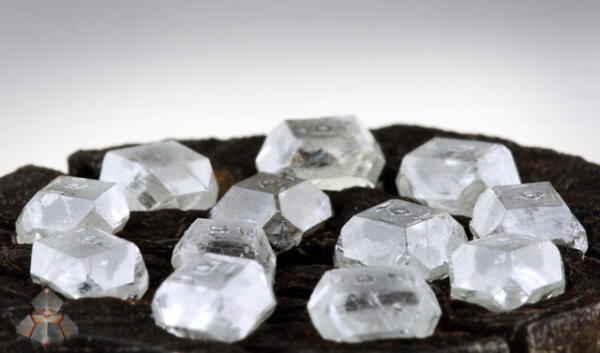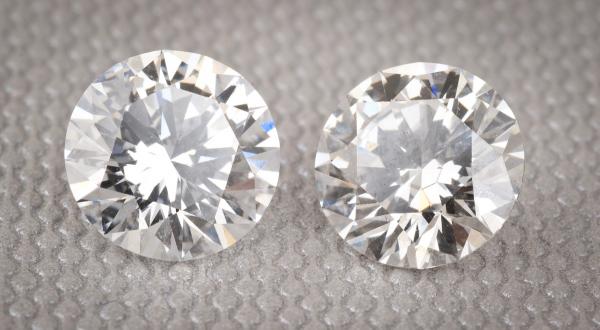Is a Lab Grown Diamond Right for Me?
The Pros and Cons of Setting a Man-Made Diamond in Your Engagement Ring
Picking a diamond for your engagement ring is a big decision. For most of us, buying a diamond is a significant financial undertaking, and we want to get it right. Unfortunately, understanding diamonds takes a lot of specialized knowledge that most people don’t have (anyone remember their refractive indexes from high school physics?).
Even more unfortunately, the diamond industry suffers from a lot of misinformation and paranoia both from inside the trade and from outside observers. I have heard people say that natural diamonds come with a 400% mark up, or that most mined diamonds are conflict diamonds (both wild falsehoods). On the other hand, I have heard some in the industry refer to lab grown diamonds as fakes (also completely false). We’re here to help cut through some of the rhetoric, so you can make an informed and logical decision about what kind of diamond is right for you.
First of all, if you’re not sure what a lab grown or synthetic diamond is, please check out our basic introduction to lab grown diamonds before reading on. So, how should you decide if a lab grown diamond is right for you? Let’s take a look at the pros and cons.

Pros, the benefits of lab grown diamonds
- The first and most often cited benefit of lab-grown diamonds is their environmental sustainability. While this issue hasn’t been full studied yet, it is generally accepted that it takes considerably less energy to grow a diamond in a lab than it does to dig it out of the ground. There is also no need to displace many tons of earth to create a lab grown diamond.
- You can, with 100% certainty, know the origin of your diamond. The issue of conflict or “Blood” diamonds is very prominent in many consumers’ minds. While the real world issue is not nearly as severe as many people believe it is (over 99.9% of natural diamonds are conflict free, and you can buy verifiable Canadian diamonds of known origin if you want), it is still reassuring to know that with lab grown diamonds, you can be totally confident that your diamond did not support wars or child labor in any way. You can learn more about conflict diamonds here.
- The price is another big benefit of lab grown diamonds. With current technology, the price of a lab-grown diamond is fairly comparable to natural diamonds. However, you can still save 10-30% with a lab grown synthetic over a natural in most cases. Also, the savings go way up if you are looking for a colored diamond (natural colored diamonds are extremely rare and consequently very expensive).
- Lab-grown diamonds are new and exciting. To put it mildly, the jewelry industry has been around for a long time. It’s quite rare that something truly new comes around. Even though man-made diamonds have been around decades, we have only recently begun to see them reach a level of quality and size that is comparable with natural diamonds. Owning one can make you something of a trendsetter.
Cons, why not to buy a lab grown diamond
- When you buy a recycled natural diamond, you limit the environmental impact significantly. This isn’t really a con of lab grown diamonds, but it is something to think about before you decide that buying one will save the planet. Diamonds are incredibly durable, and we have been in the diamond recycling business for over 25 years. Once a diamond has been mined and cut, it can pass from generation to generation, diffusing the environmental impact of mining the diamond significantly.
- Many people might not understand what a lab grown diamond is. Of course, you don’t have to tell anyone you bought a lab grown diamond (and even experienced gemologists might not be able to tell). But, due to that misinformation we talked about earlier, most people don’t know what a lab grown diamond is. They might think you were cheap and bought a CZ or a fake diamond instead of the real thing.
- Just as lab grown diamonds support more advanced economies, they also take jobs away from developing economies. When run responsibly, a diamond mine is a huge benefit to the economy of the host country. Often times, these countries are impoverished, and the jobs and income that the mine brings can help elevate many people out of poverty.
- Lab grown diamonds are not one-of-a-kind in the same way that natural diamonds are. Each earth-mined, natural diamond is a unique work of nature’s art. Lab grown diamonds, on the other hand, are mass-produced in diamond factories. The mystery or glamour of the diamond may feel lost because of this.
- You lose something of the magic, the sense of awe, the “it factor” that comes with a natural diamond. This one may seem silly to some, but there is something special about knowing your diamond has a rich history and tradition behind it. Our parents, and our parents’ parents, and so on going back hundreds of years wore natural diamonds. A natural diamond has likely spent millions of years under pressure, being refined by processes of the earth before it was discovered and brought to the light. Some of the romance is lost when you compare this to the sterile environment of a modern lab.
Should I buy a lab grown diamond?
This decision is, of course, up to you. Don’t let yourself be pressured or guilt tripped into buying a diamond that you don’t love. There are plenty of people out there who will tell you that it’s morally wrong or unethical to buy a natural, earth-mined diamond, and visa-versa. Hopefully, by now you know that this is (to use a technical term): bologna.
The key is to decide what is most important for you in a diamond (peace of mind, romance, price, how you feel about the purchase, etc.). Now that you understand the true benefits and disadvantages of lab grown diamonds, you can make the decision that’s right for you. Whatever diamond you decide on, Arden Jewelers has you covered with a selection of natural and lab grown diamonds, beautiful jewelry to set them in, honest and upfront descriptions of every product, and a proven track record of incredible prices.
P. S. If you are considering a lab grown diamond, be sure to checkout Balance, our own collection of unique engagement rings made exclusively with lab grown diamonds and recycled gold.

Is lab grown diamond Gia graded? How can you tell a lab diamond from moissanite?
Hi Cindy, good questions. GIA has recently started to provide grading reports (digital only) for lab grown diamonds. Before that GIA would refuse to grade them. Labs like IGI have been grading lab grown diamonds for many years, however.
Telling a lab diamond apart from a moissanite is actually pretty easy. Because they are chemically different materials, they have different properties. There are dedicated moissanite testers that you can use. The easiest test though relies on the fact that moissanite is doubly refractive (DR) and diamond (lab or natural) is singly refractive (SR). You can look for the visual cues to see if the stone is DR. If it is, you definitely don’t have a diamond. 🙂
Are you able to get insurance on a lab diamond?
And do you sell natural diamonds?
Hi Sheryl, good questions. Yes, you can get insurance on a lab grown diamond the same way you would with a natural diamond. Your insurance agent will likely need an appraisal which is something most gemologists can help with. Yes, we do sell natural diamonds. You can see a small portion of our inventory online here or come visit us in person to see more options.
How much would three carat lab grown studs go for?
Hi Lanie, thanks for reaching out. That will vary a lot based on the quality of the diamonds. If you are interested in buying some, please feel free to contact us, and we can help you find the perfect pair of studs.
Thank you so much for the information! Very helpful! I would love to hear what`s the carbon footprint of natural diamond vs man-made diamond? Can you tell?
Hello Anna-Liisa, that’s a very good question. Unfortunately, there isn’t much comparative data readily available. A recent study found that mining a natural diamond emits about 3 times less greenhouse gases than making a lab grown diamond of the same size. However, that study was paid for by the world’s largest diamond mining group, so it’s best taken with a grain of salt.
Will a lab grown diamonds worth hold up over time?
Hi Denise, good question. Technology and the global supply of lab grown diamonds are both changing rapidly at this point in history. As techniques for producing them improve and more manufacturers enter the market we have seen prices lower in recent years. Of course, we can’t predict the future better than anyone else, but the long term value of lab grown diamonds is definitely less certain than natural diamonds at this time.
Hi I heard that lab grown diamonds breaks easily
Hello Karan, thanks for asking. Since lab grown diamonds have the same properties as natural diamonds, they are just as strong and durable. Of course, all diamonds are very hard but not indestructible. If a diamond (natural or lab grown) is hit hard enough at the right point it will break. Of course, if a lab grown diamond is poorly made and has surface reaching impurities, that could cause it to break easily, but such a stone would be easy to identify for a professional gemologist and we would not sell it in our store.
are man made diamonds better then real diamonds.
Hello, thanks for commenting. I wouldn’t say they are better than natural diamonds, but in terms of their chemical structure and sparkle they are the same. Which one is better for you is a decision that only you can make. 🙂 If you are in the market for a diamond, feel free to contact us to discuss more of the pros and cons of each diamond type.
Will a lab grown diamond lose it’s luster over time?
Hi Robin, good question. The answer is: no. Since lab grown diamonds are chemically identical to natural diamonds, they have the same properties. They will maintain their luster and shine for as long as a natural diamond does.
Can’t any astute person with a jeweler’s loupe see the Lab diamond has no natural flaws?
It seems then identification is simple.
Hello, good question. Unfortunately, the identification is not that simple. There are many natural diamonds without flaws and the flaws found in lab grown diamonds are not always obvious even under high magnification. There are several good indicators, but currently, sophisticated laboratory equipment used by an expert gemologist is required to make a positive identification.
Excellent
Hi Ramil, thanks! We’re glad you liked the article.